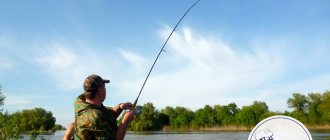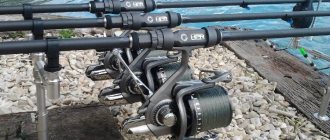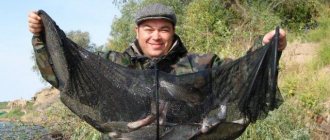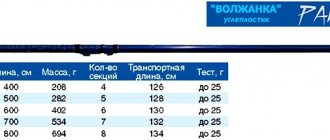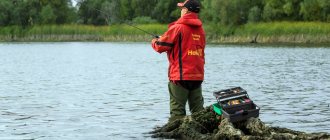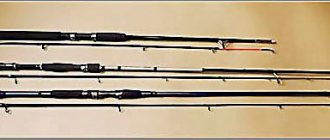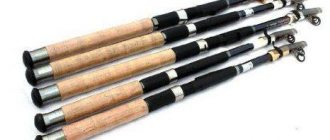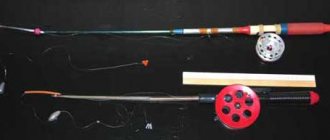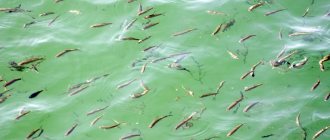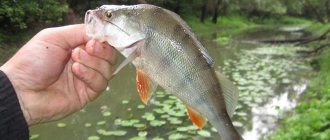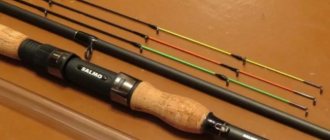Feeder fishing has gained its popularity and rapid development not only for the yield of the method, but also for interesting fishing strategies that allow the most ambitious desires of the fisherman to be realized in catching trophy fish throughout the open water season. This type of bottom fishing, combined with the possibility of baiting by including a miniature feeder in the equipment, allows you to catch the vast majority of peaceful fish species in our reservoirs.
The versatility of the gear has now brought it to the rank of one of the most common types of fishing, which every self-respecting angler should own. This article will be devoted to the secrets of feeder fishing, reading which will help in organizing feeder fishing not only for beginners, but also for anglers already familiar with this matter.
What is a fishing feeder
Feeder fishing is based on the principles of synchronized supply of bait and targeted feeding of fish in a certain fishing zone, which significantly increases the likelihood of bites. The word feeder itself means to feed, which fully characterizes this bottom method . The equipment included with a cord with a feeder and a hook is the basis. It is based on feeder gear in the form of a fishing rod specially designed for this method with a large number of throughput rings and the ability to change the sensitive tip, called a quivertip. To store the fishing line, deliver the rigs to the fishing point and reel in the caught trophy, a spinning reel with certain performance characteristics and the presence of a clip for fixation, determined for casting the length of the cord, is used.
Feeder on the river casting features
The feeder cast is made from behind the head, not the shoulder, since casting over the shoulder does not provide the required accuracy. Starting position: the left hand with the butt of the blank is directed towards the casting point, and the right hand is located above the top of the head. During the flight of the tackle, we continue to hold the rod raised up and when the line reaches the clip, or marked area, we feed the blank forward and lower it parallel to the ground.
If you throw the feeder downstream, at an angle of 45 degrees or less, then fishing with a feeder on the river will be possible right next to the shore, the advantage of such fishing is that you are at a distance from the fish, and it does not see or hear you.
It happens that you pick up a feeder, and it flies perfectly, there are no overlaps, you react to bites in a timely manner, but you have a desire to try to throw a little further, where the current is stronger. Of course, you can install a heavier and larger feeder. But the problem is that the larger the feeder, the more windage it has and there is a possibility that it will not stay with the current, but will be carried away. In this case, we need to add additional weight to our feeder by placing a 10-20 gram ear through the winding ring; in this case, the weight of the feeder will increase, but the windage will not. The sinker must be secured inside the feeder, then it will not get caught on it and the tackle will not get tangled.
What elements does the tackle consist of?
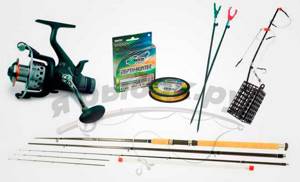
Feeder for beginners to master this fishing method begins with assembling a kit with the selection of certain operating parameters of the component elements of the tackle. Operating parameters depend on fishing conditions and the amount of fish expected in the catch. The composition of the tackle itself has a constant set of accessories, more similar to the spinning rod, but with some specific differences, as can be seen from the list below:
- rod;
- nylon fishing line or braided cord;
- spinning reel;
- equipment consisting of: feeders, weights, leashes, hooks, anti-twisters, stoppers;
- a set of interchangeable tips or quivertypes;
- bite alarms;
- auxiliary equipment that allows you to comfortably fish on the feeder.
Next, we will consider the parameters of each element of the gear, scrupulously delving into their varieties and characteristics.
What is feeder tackle?
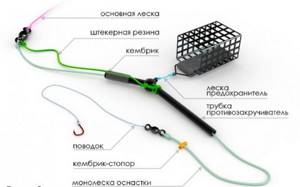
A feeder is one of the well-known tools designed for bottom fishing (peaceful fish), using a specially designed feeder rod and a feeder, which also serves as a sinker. The bite indicator in such rods is interchangeable tips of a certain flexibility, designed for various fishing conditions. This nuance can be attributed to the features of feeder fishing. What is still needed for fishing to be considered feeder?
Rod. For feeder fishing, special rods are produced, both telescopic and plug-in. The presence of different flexible tips in the kit allows you to use feeders of different weights. At the same time, instead of feeders, you can install ordinary sinkers, depending on the fishing conditions. Therefore they say:
- picker-quivertypes – for fishing with sinkers;
- feeder quivertips - for fishing with feeders.
In retail outlets you can find rods with lengths from 1.8 to 4.5 m. Depending on the length of the rod, the casting distance also depends. The tips have their own sensitivity and their own test. To avoid confusion during the installation process, they are painted in separate colors.
Coil. Bottom fishing does not require special reel performance, so any spinning reel equipped with a front or rear drag will do. When fishing for carp or carp, especially larger ones, you will need a reel with a baitrunner.
Main line. Since you plan to fish at a considerable distance from the shore, it is better to take a braided fishing line. It does not stretch and is able to quickly transfer bites to the tip of the feeder. In addition, it is stronger and more stable than monofilament fishing line.
Feeder. The feeder, its dimensions and its weight are selected depending on the casting distance, as well as the presence of a current. As for the shape of the feeder, this is not of fundamental importance.
Leash. Monofilament fishing line or fluorocarbon are used as leashes. Recently, fluorocarbon has been used more often because it is invisible to fish in the water. In this case, you should always install leashes whose breaking load is less than the breaking load of the main fishing line.
Hooks. Hooks are selected depending on the type of fish being caught. For example, when fishing for carp, carp hooks are used. Hooks come in both thin and thick wire.
Rod stand. Feeder fishing does not involve constantly holding the rod in your hands, like fishing with a regular float rod. Having thrown the tackle into the water, the rod rests on the stand. You can use a regular wooden flyer, cutting it directly onto the pond.
Fishing. Do-it-yourself feeder tackle.
Feeder for fishing
The fishing rod is the basis for the installation of feeder equipment, differing in the composition of the blank material, its length, test and action. Blanks can be made from composite, carbon fiber and fiberglass materials. It is this list of materials that makes the fishing rod both lightweight and capable of withstanding heavy loads during fishing.
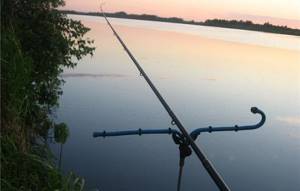
The casting distance directly depends on the length of the tackle, and since bottom fishing in this method already initially implies long- and medium-distance fishing, the length parameters of the fishing rod vary within 2–4.5 meters. The test determines the possibilities of using a certain weight of equipment. It is graded from ultra-light to very heavy, allowing you to fish with a feeder in strong currents. The structure of the blank affects the sensitivity of the tackle and the comfort of casting. This setting ranges from very fast to slow. As a rule, feeder fishing for beginners begins with the purchase of a fast-action fishing rod, which allows you to make long casts with not yet thoroughly developed equipment, as well as more clearly track the smallest bites.
How to choose a feeder rod
Before you go to the store to buy a feeder rod, you should answer a few simple but important questions.
If this is your first experience, then it is better to opt for an inexpensive universal “stick”. As the angler gets to know the gear, he will have specific requirements for the rod. All parts of the feeder tackle assembled
When casting equipment long distances, when fishing in the current, a feeder of greater length and test is required. You also need to take into account the size of the intended trophy. For example, to catch crucian carp in a pond, a more delicate rod is required than when fishing for carp and carp.
It is important for the fisherman to take into account the number of trips to the reservoir. It’s one thing when a person goes fishing 2-3 times a year, and the rest of the time an expensive fishing rod gathers dust in the closet. But if an angler spends every weekend or entire vacation on a river or lake, then the use of a professional feeder rod is justified.
The main parameters that characterize the feeder rod are:
- test;
- length;
- material.
It is also worth considering the expected casting distance and the size of the fish. The first thing you should look at is the performance characteristics of the feeder rod.
Rod test
Each rod is designed for specific fishing conditions. In order to optimally use the properties of the feeder, the weight of the thrown load is indicated on the form of the rod or there is an inscription that indicates the maximum loads.
- The inscription Light means that the rod is light, it can cast equipment weighing up to 30 g;
- Medium-Light speaks of using feeders weighing up to 60 g;
- Medium – from 60 to 80 g;
- Medium-Heavy – from 80 to 100 g;
- Heavy – from 100 to 120 g;
- Extra-Heavy – over 120 g.
Using feeders with lighter weights will negatively affect the sensitivity of the feeder, and exceeding the test limit increases the likelihood of rod breakage.
Rod length
Feeders are often purchased for specific fishing conditions. The length of the rod depends on several factors:
- angler's height;
- feeder weight;
- fishing conditions;
- casting range.
Currently, rods are produced with lengths from 2.7 to 4.8 m in increments of 0.3 m. Some English models have their own length scale.
The most common are feeders with a length of 3.6 to 3.9 m. Such fishing rods are convenient for casting rigs over long distances.
In addition, these rods give you complete control over your rig. To cast bait over long distances, a rod more than 4 m long is required.
In addition, feeders 4.2-4.8 m long are designed for fishing in strong currents. The rod is installed vertically on the shore to reduce the length of line in the water.
In some models of feeder rods, it is possible to increase the length due to an additional elbow. Thus, the angler will actually have two fishing rods of different lengths.
Rod material
Every angler wants to buy a feeder rod that will last for many years. Reliability largely depends on the materials used.
Feeder rods are made from three main materials:
- carbon fiber;
- fiberglass;
- composite (a mixture of “glass” and “coal”).
Carbon fiber. Despite the fact that carbon fiber is considered a modern material, it has certain disadvantages.
The most important of them is the high cost of the rod.
The second disadvantage of carbon is the delicacy and fragility of the product. Therefore, experienced and careful fishermen should buy a high-quality carbon fiber rod.
Composite For beginner feeders, a “stick” made of composite material will do just fine. Although such a rod will be somewhat heavier and stiffer, it will last a long time.
Fiberglass. In extreme fishing conditions (extreme casting, heavy feeders, catching large fish), the use of fiberglass rods is justified.
Choosing a spinning rod - what characteristics to look for, detailed review.
About how to choose the right reel for a spinning or feeder rod.
Reels
It is more convenient to fish on a feeder using a spinning reel. This mechanism is selected with gear ratios up to 5, which indicates the priority of the power direction of the coil in relation to its speed characteristics.
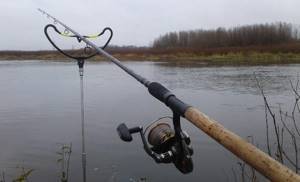
Spools for fishing with a feeder are voluminous, allowing them to accommodate at least 100 meters of various types of cord. It is advisable to have two units of the element in the kit to allow for variations with the cord. As a rule, values of 3000–5000 cover any fishing conditions. Ideally, a spinning rod should have two types of brakes: the main friction one, its rear location is considered the most convenient, and a baitrunner, which allows you to protect the rod from being pulled into the water when particularly large fish bite.
Main line and braid
Feeder fishing can be done using two types of main lines: braided and nylon. Braided lines are recommended for use at long fishing distances, starting from 25 meters. The material of the braided cord is less susceptible to stretching, and therefore better transmits signals from bites. The thickness of the braid is accepted in the range from 0.12 to 0.22 mm. Nylon fishing lines work great at short fishing distances, and are also indispensable when fishing shell jars and bottoms with pebbles, due to the material’s high resistance to abrasion. The diameter of the monofilament for feeder fishing is taken in the range of 0.18-0.30 mm.
Leashes
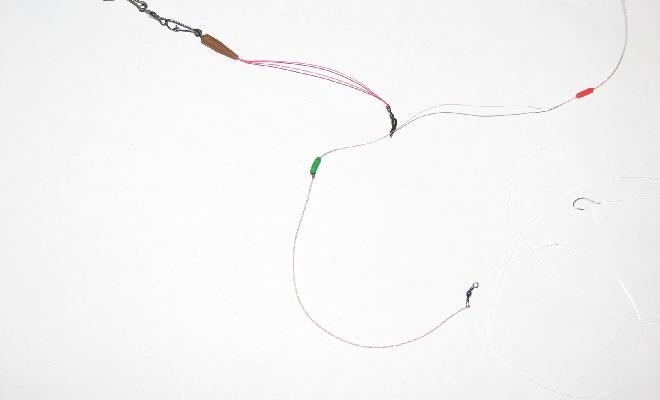
It is recommended to use an element such as a leash made of nylon fishing lines, which are softer in structure, which does not alarm the fish so much when biting. Nylon makes the rigs more delicate, and therefore allows you to increase the number of bites. The length of the leader material depends on the activity of the fish and generally fits into sizes from 20 to 70 cm.
Important! The more active the fish, the shorter the leash length is needed.
Sometimes, with passive fish, fishing on a feeder on the river is carried out with extended leashes, reaching lengths of 1-1.5 meters. For leashes, line diameters range from 0.10 to 0.20 mm. The best results are shown by transparent and black monofilament. For feeder fishing, leashes of various lengths are prepared in advance at home, which makes it possible to adapt to the existing fishing conditions while fishing without wasting time.
Feeder rigs for fishing in the current
There are constant debates on forums about which feeder equipment is better on the current. Each fisherman defends his point of view. Any classic installation works - paternoster, Gardner loop, asymmetrical loop, anti-twist tube. These are universal ties that can be fished both on a riser and on a pull. There is no special feeder equipment for the current - we work with classic ones that we can fish with. There is no magic pill - you need to experiment with installations on a pond, select the length of the leash and the size of the hooks. Article about feeder installations:
The best feeder rig for the current is the one with which the angler successfully fishes. On the line, due to the inflatable loop of the main line, sometimes it is not immediately possible to adapt to detecting a bite. Here you need to select. The bait gets eaten up without any bites - we put the leash shorter, and vice versa. There are no bites - we try to use long leashes, sometimes up to 1.5 meters. Sometimes the fish stays lower in the feeding trail and does not approach the feeder. For example, a helicopter feeder rig and two units for fishing on currents in the water column implies the use of leashes generally up to 3 meters long - if the length of the rod allows such a cast. The bait on such a long leash sinks to the bottom for a long time, counting on the fish that feeds in the depths. Even bream takes this kind of bait in the spring, although it is considered a purely bottom-dwelling fish. Read more about rigging a bream feeder for currents.
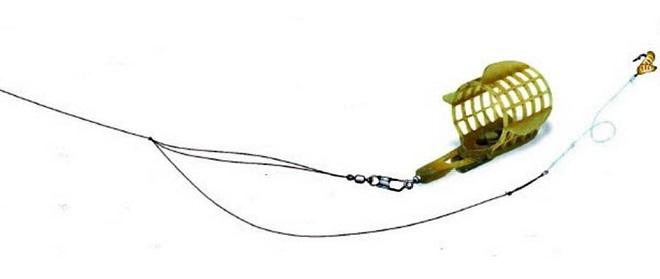
Gardner's Paternoster
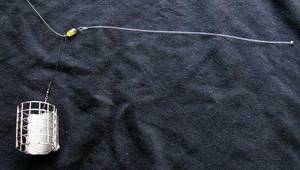
Running
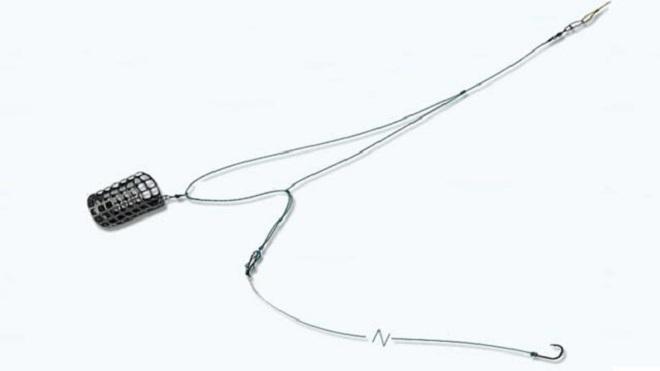
Asymmetrical loop
On average, the length of the leash for a feeder in a current is longer than when fishing in still water. Even a long leash will still stretch from the feeder down in the direction of the pull. This can be 60 cm, in other conditions – up to 1.5 meters. The working length is selected during fishing each time - the behavior of the fish differs at different times. Typically this range is 0.6-1.2 meters. Peculiarities of biting change depending on the activity of underwater inhabitants. You can’t predict in advance what length of leash to put on the feeder during the current - it’s better to keep prepared bundles in the leash so that you can quickly change them on the pond without tying them. We knit leashes from soft monofilament or fluorocarbon with a diameter of 0.1-0.14 mm for small and medium fish, up to 0.25 mm for carp or large chub and ide. Article about leashes for the feeder:
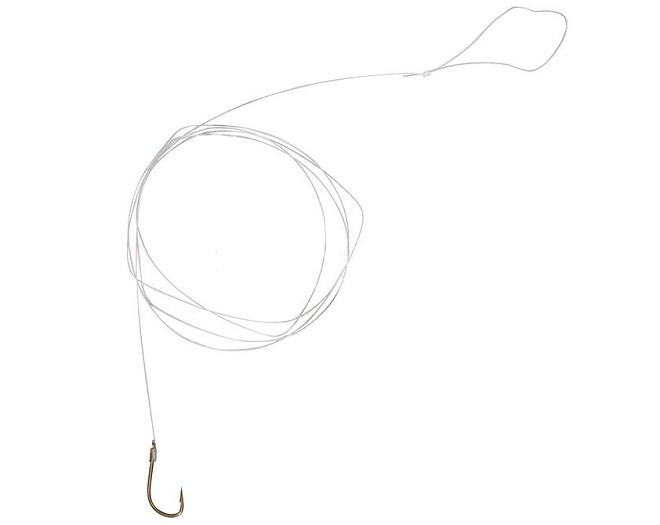
Hooks
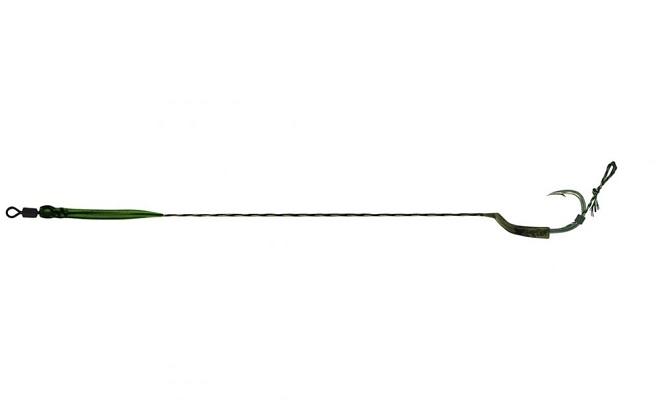
Feeder fishing is carried out with different types of hooks, which depend on the type of bait used. Depending on the volume of the bait, hooks with sizes from 10 to 16 units are used. The requirements for hooks do not differ from generally accepted fishing standards, and these are the sharpness of the tip and an elastic steel composition that does not lose its shape under loads. The color of the accessory is selected to match the shades of the attachments.
Important! For animal baits, bloodworms, maggots and worms, thin hooks are suitable, which injure the bait to a lesser extent, prolonging the active phase of its behavior in the water.
The thickness for plant attachments does not matter much. The main thing is that the bait stays securely on the hook. The selection of the shape of the hook fastening element depends on the fisherman’s ability to correctly and securely tie the accessory to the leash.
Feeder
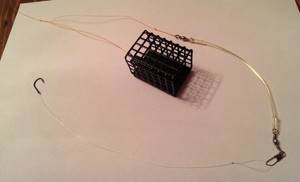
The basis of feeder fishing is the feeder. For each act of fishing, a special type of accessory is used. There are feeders for starting feeding, for long-distance casting, additional feeding feeders for calm water, additional feeding feeders for currents, feeders for live food and method variants of this expressive element of equipment. Despite the varied purposes of each option, the main purpose of the feeder is to deliver the bait mixture to a specific fishing point, lure fish and keep them in the selected fishing area.
Feeders differ in the material they are made of. The accessory can be either metal or plastic. In addition, in terms of design, this element is made with different mesh sizes or perforations, which affects the quantitative component of the feed supply, and different weights, because the feeder in the equipment additionally acts as a sinker. In addition to mesh feeders, spring and open or method type feeders are common.
Bite alarm
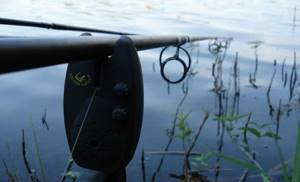
Special alarms, which can be either audio, visual or combined, allow you to timely record and detect bites. The most common and practical alarms in bottom fishing are those in the form of a bell or bell, which are installed on a cord or quivertip tackle. Some fishermen prefer to detect bites directly by the tip of the rod, but such fishing can certainly be carried out with only one tackle. There are electronic bite alarms on sale that convey the contact of the fish with the bait with sound and light, and some kits are even equipped with a pager to transmit the signal over a distance. Such alarms are convenient not only for fishing in the daytime, but also comfortably allow you to fish in the dark.
Rod stand
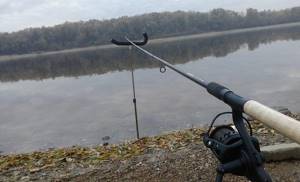
Feeder fishing is more conveniently done using specialized rod stands. This role can be performed by both ordinary sliding fliers familiar to floaters, and stands designed for feeder fishing called rod-pods. These types of tables are designed for simultaneous use of two or four fishing rods. They are adjustable in height and angle of inclination relative to the water's edge, which adds comfort to fishermen when fishing even in strong windy weather. The flyers are installed directly into the soil of the coastline at a height that ensures easy fishing and tracking of bites. The use of a pair of such devices allows you to position the rod not only in a vertical, but also in a horizontal position.
Equipment for feeder fishing
The function of the bottom rod equipment is based on the direct transmission of the bite from the leash to the tip of the tackle without interference from the feeder. To carry out this action, fishermen have developed a number of specific matings that provide the necessary fishing conditions. Fishing with a feeder in still water is carried out using rigs such as a symmetrical loop and paternoster. To conduct feeder fishing in the current, an asymmetrical loop, rigs with anti-twist tubes, as well as the technique of tying a sliding feeder or inline are used. Each type of installation has its own specific formation algorithm, which requires the fisherman to have knowledge and practical skill in tying various types of knots used in fishing equipment.
Types of feeder equipment
There are several types of feeder equipment, differing from each other:
- According to the fastening of the tip: blind or sliding.
- By type of feeder: open or closed.
- According to the placement of the leash: below or above the feeder.
Paternoster
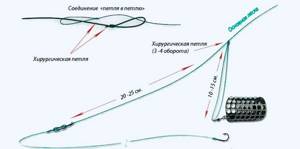
This is the most common and simplest version of feeder equipment. In this rig, the leash is placed below the feeder. To get a “paternoster”, it is enough to form two loops on the main fishing line. A smaller loop is knitted at the end of the main line. A leash with a hook is later attached to it. The second loop, larger in size, is formed at a distance of 25-30 cm from the first. A feeder is attached to it. The leash is fastened according to the “loop to loop” principle, and another method can be used to fasten the feeder, using swivels and latches, fasteners.
Symmetrical and asymmetrical loop

This type of equipment allows you to attach the feeder using a sliding method. In this rig, the feeder is also located above the leash. Sliding installation is done like this: take a piece of fishing line about 1 meter long and fold it in half so that one end is 15-20 cm longer than the other.
At the end of the fishing line, folded in half, a small loop is knitted, to which the leash will later be attached. After this, the fishing line is tightly twisted and, after 5-10 turns, a surgical knot is tied. A swivel with a clasp is attached to a long piece of fishing line to secure the feeder. After this, the ends of the fishing line are tied in such a way that the shoulders of the large loop along which the feeder will slide are the same. As a result, you get a rig that is called symmetrical. At the opposite end from the leash, it is necessary to form another loop in order to connect the equipment to the main fishing line.
An asymmetrical loop is knitted in a similar way, but with the difference that the loop along which the feeder slides must have arms of different lengths. In this case, the feeder should be attached to a longer arm.
Anti-twist tube

The equipment is based on a sliding installation with a feeder, which is connected to an anti-twist tube. The tube is put on the main line, and at the bottom and top of the tube, on the main line there are restrictive rings. They limit the free movement of the tube to which the leash is attached.
"Harvester"

This equipment option also involves the use of an anti-twist tube, but for attaching the feeder.
"Inline"

This is a very simple rig, but similar to a sliding feeder rig. The only difference is that the feeder is attached to the main line. The sliding of the feeder along the main line is limited by 2 stoppers located at the top and bottom of the feeder. A leash with a hook is attached to the end of the main line.
"Helicopter"
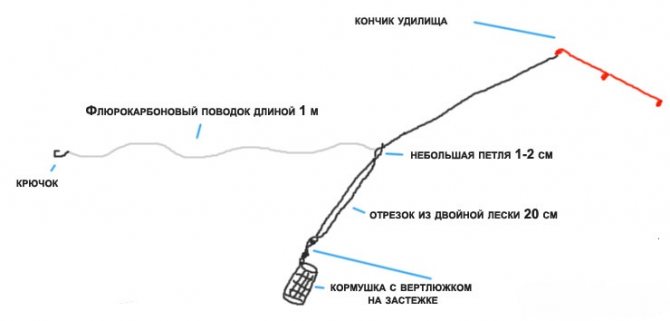
This equipment, where the feeder is firmly attached to the end of the main fishing line, and the leash moves along the fishing line. The same 2 stoppers limit the slipping of the leash. A swivel with a latch is mounted on the leash. There are two stoppers installed on the main line: 1 at a distance of 25-30 cm from the feeder, and the other stopper can be installed at any distance. The main thing is that the leash rotates freely around the fishing line. The helicopter rig is suitable for fishing on rivers with a current.
How to assemble feeder equipment, step-by-step instructions:
- The rod is assembled and the tip is installed. All rings must be on the same line.
- The reel is installed on the reel seat.
- The fishing line is wound onto the reel, after which it is passed through all the rings.
- A shock leader must be attached to the end of the fishing line if heavy feeders are used.
- Equipment is attached to the shock leader, which is selected for specific fishing conditions.
After such actions, we can say that the feeder tackle is ready for use.
Best HD Feeder Montages
How to fish on a feeder correctly
When organizing feeder fishing for novice fishermen, the fundamental point after assembling the gear itself is the competent choice of a place with clear definitions of its characteristics, based on which both the technique and the fishing strategy will be determined. Next, the reader will be presented with an optimal algorithm of actions with their specific descriptions, facilitating rational preparation and successful application of fishing techniques as a result of already proven practice.
Choosing a fishing spot
The choice of a place for fishing on a feeder is determined by several multidirectional factors, the combination of which, in optimal parameters, ultimately provides the prerequisites for successful and comfortable fishing. First of all, they inspect the coastline for obstacles that interfere with high-quality and free casting. Most often, nearby trees and dense coastal thickets negatively affect this important action. The coastal zone should allow you to freely bring caught fish ashore or allow you to work while fishing with a net.
When inspecting a reservoir, pay attention to the strength of the current and the degree of overgrowing of the water area with algae. Fishing on a feeder, on a lake, is more successful on smooth ascents from the depths and on flat plateaus with hard soils. Fishing with a feeder on the river is more promising in areas where currents slow down and in backwaters that extend deep into the shorelines. Depending on the seasons of the year, anglers are advised to search for fish on the borders of thicket areas with clear water and relatively shallow depths during warm periods of the year. At depths, along the edges of holes and on sharp slopes, they look for fish in cold water.
Determination of bottom composition
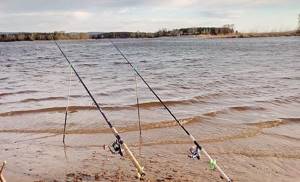
A rigid braided line with a load is guaranteed to help determine the composition of the bottom. To do this, the installation of only one weight attached to the end of the braid is thrown into the fished reservoir and the cord begins to be wound. The quivertype clearly shows the structure of the underwater soil by its behavior. Reeling without moving the tip of the rod indicates a uniform sandy bottom or one with a small layer of silt, a flat and flat bottom. A slight twitching of the quivertype signals the bottom with the presence of shell rock or pebbles. Snags and jerks during reeling indicate that the place is unsuitable for bottom fishing and require searching for a new position.
How to determine the edge when fishing on a feeder
Measuring the depth will help you accurately determine the edge, the underwater hole and the boundary of the dump. It doesn’t seem difficult to do it technically if you have certain information.
Important! A lead weight weighing 40 grams will help you correctly determine the depth. It is this mass that sinks into the water column at a speed of one meter per second.
When casting to the surveyed point, all that remains is to determine the time the weight touches the bottom, which can be seen by working out the quivertype, and thus, as a result of elementary mathematical calculations, calculate the real depth. By taking measurements in different zones, the optimal area for fishing is selected.
Calculation and recording of the distance to the fishing point
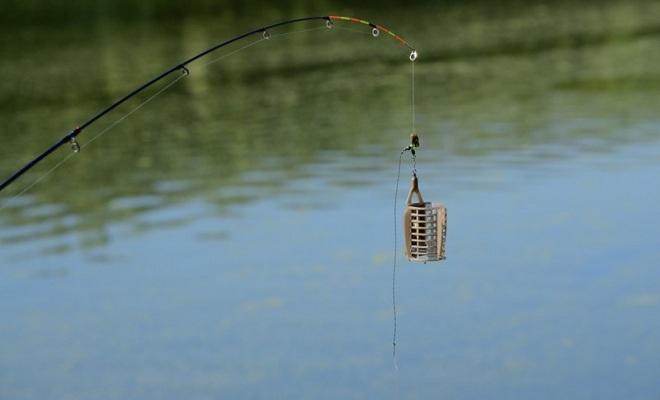
For casting at fixed distances, it is necessary to measure the required length of the cord and subsequently stop further flow of the fishing line, thus limiting its supply to the required amount. Knowing the exact casting distance, they place two pegs on the shore at a distance of two or three meters from each other and wind the cord around the pegs, feeding it directly from the reel. Two meters are added to the distance required for casting, compensating for the slack of the fishing line, and the cord for the feeder is clipped into a specially available spinning reel device.
Formation of a feeding spot
To collect fish at the fishing point, it is necessary to form a feeding spot at the bottom, or what is also called a feeding table in the fishing community. For these purposes, the food is made crumbly so that its consistency and density allows you to quickly empty the feeding trough supplied to the fishing point. Thus, a spot is formed by feeding five or ten feeding feeders and only after that they begin fishing with bait and replacing the feeder with a working version. In addition to forming a table with feeders at short distances, you can make a spot by direct casting from your hand or by feeding balls of bait from a slingshot. Over long distances, feed is delivered using a device called a rocket, or using a radio-controlled feeding boat.
Feeder casting
Throwing a feeder is done in several ways, depending on the range and required accuracy of feeding equipment. Casting from behind the back, made from a standing position, allows you to achieve high accuracy. The same technique will help increase the range of the serve, but from a run, for which it is enough to take three or four steps. The pendulum and English casting techniques require certain skills and are recommended for use after reliably mastering casts from behind the back.
Important! Before casting, it is mandatory to inspect the tip of the rod to prevent possible tangling of the fishing line, which, if careless, will inevitably break the quivertip and render the tackle unusable.
Proper rod installation
After casting, the rod is placed on a stand. This can be done in different ways by installing the tackle in a vertical or horizontal position at a certain angle to the water. Feeder equipment for fishing in currents and with excessive wind load is better controlled when installed horizontally. After installing the tackle itself, the cord is pulled through the reel until the tip of the rod is slightly bent towards the water. The stands are placed no closer than a meter to the quivertype. A shorter distance seriously reduces the sensitivity of the gear.
Sweeping
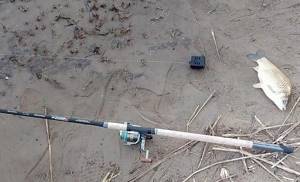
The bites of fish of different sizes differ significantly from each other. If a small fish bites with small twitches of the rod tip, then a large trophy quite noticeably bends the quivertip, or the bite is expressed by a sharp blow that shakes the entire tackle.
Important! Small twitches followed by the cessation of biting within three to five minutes indicate that the bait has been eaten by small things and needs to be changed.
The structure of the feeder tackle gives a certain amount of time to carry out the hooking, which is not worth fussing with, but it is better to focus on the correct technical component of the execution of the element. Having selected the moment at the bend of the quiver tip, the angler must lift the rod and smoothly pull it towards the shore. A sharp and strong pull can break the leash or damage the fish by tearing the lip and causing it to inevitably fall off. Having felt heaviness and resistance after the pull-up, you need to start playing.
Fishing
The final stage of the feeder fishing technique is landing the trophy. When catching small fish, fishing is carried out by ordinary uniform winding of the line using a reel, followed by lifting the fish ashore using the rod blank.
A large specimen will require pumping out, which in the technical version is carried out by lifting the rod up, while pulling the fish up at an angle of 70–80 degrees and then lowering the tackle to the water while simultaneously reeling out the free line. Thus, as a result of balanced and rhythmic actions, the trophy is brought to the shore to the fishing spot on the shallows or to the bridge and taken into the landing net.
Which feeder test to choose
The rod blank test implies the load for which it is designed, namely what weight the feeder will be used. If you use a feeder that is lighter than the test specified on the feeder form, then you will significantly lose the sensitivity of the feeder, and if the weight is higher than the upper limit of the test, then you risk breaking the rod. According to the test, feeder rods are divided into: • Ultralight (Ultralight) - up to 40 g; • Light (Light) - up to 80 g; • Average (Medium) – 80-100 g; • Heavy (Heavy) - 100-120 g; • Extra heavy (Extraheavy) - 120 g or more. The higher the rod test, the heavier the feeder can be used. Accordingly, the further you can throw the bait. Also, when choosing a fishing rod test, you should take into account the body of water, or rather the strength of the current in it. When fishing in a current, you need to choose a feeder with a weight that will not be carried away by the current, so when choosing a feeder test, focus on the speed of the current and casting distance. It is worth considering that if the bite is bad, it is better to use feeders as light as possible. Often in cold water, when the fish are very cautious, you have to fish with feeders weighing 20-30 grams. But you won’t be able to throw such a feeder with a rod with more than 60 grams of dough. Light feeders require a lighter feeder. If you haven’t fully decided which test to choose for a feeder, pay attention to the most universal option - a middle-class rod with a top test of up to 90-100 grams. This test will be optimal for a novice angler and is suitable for most fishing conditions. And then, based on your practice, you will be able to understand which test of the next feeder is best for you.
